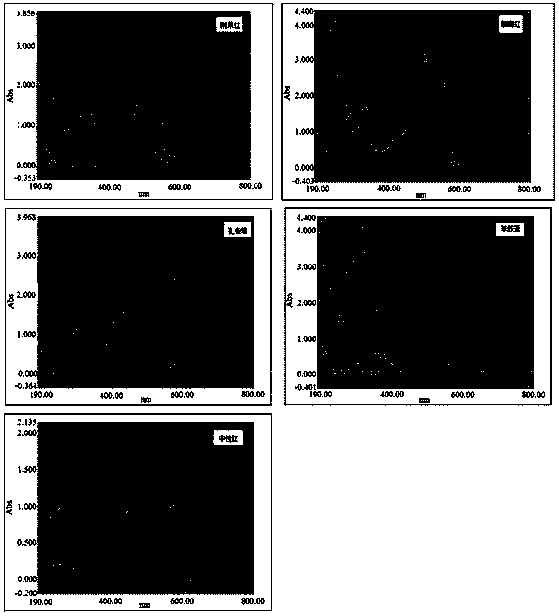Bacillus subtilis multifunctional bacterial strain and application thereof
A Bacillus subtilis, multifunctional technology, applied in the field of microorganisms, can solve the problems of lack of multifunctional microbial resources and low degradation rate, etc.
- Summary
- Abstract
- Description
- Claims
- Application Information
AI Technical Summary
Problems solved by technology
Method used
Image
Examples
Embodiment 1
[0026] Example 1 Separation and Purification of Bacterial Strains
[0027] Obtain litter samples at the end of the soil freeze-thaw period from the original forest of Minjiang fir, take them back to the laboratory and store them at -4°C, and prepare the rest as litter powder (freeze-dried, chopped and passed through a 40-60 mesh sieve) and destroyed Store in polypropylene bags at -20°C.
[0028] In inorganic salt medium (inorganic salt medium: K 2 HPO 4 1g / L; NaH 2 PO 4 1g / L; (NH4) 2 SO 4 0.5g / L; MgSO 4 0.2g / L; CaCl 2 0.1g / L; FeSO 4 0.05g / L; MnSO 4 0.02g / L; dH 2O 1000mL; pH7.2; sterilized at 121°C for 20min), add 0.5g-4°C preserved litter samples per 100mL of culture medium, culture at 37°C, 180r / m shaker for 3 days, take the enriched solution by 5% The inoculum amount was inoculated into the same fresh medium, cultured under the same conditions for 3 days, after 3 times of transfer, take 0.1mL of culture solution and spread it on BM containing 0.1g / L aniline...
Embodiment 2
[0029] Identification of embodiment 2 strains
[0030] (1) Individual characteristics
[0031] The above-mentioned strain MZS1 is positive for Gram staining; the bacterium is rod-shaped, with blunt round ends, about 1.5-2.25 μm in length and 0.5-0.75 μm in width; it has a spore shape, and the spores are oval, mesozoic or nearly mesozoic , the sporangia are not obviously enlarged (see figure 1 ), flagellar periphysis (see figure 2 ); young cells grown on glucose nutrient agar were lightly stained with Lu's methylene blue staining solution, and there were no non-colored particles in the protoplast; the turning movement of the bacteria was observed on the phase contrast microscope.
[0032] (2) Group characteristics
[0033] The colony of the strain MZS1 grown on the beef extract peptone solid medium was irregular dry, off-white, opaque, slightly protruding, wrinkled, with irregular raised edges, and the colony was close to the medium, so it was difficult to pick. Stay filmy...
Embodiment 3
[0042] Example 3 Degradation of lignin and cellulose
[0043] Inoculate Bacillus subtilis MZS1 into LB liquid medium, and culture it with shaking at 37°C and 150r / min for 16h. According to the inoculum amount of 5% (V / V), inoculate the bacterial liquid to the fermentation medium (fermentation medium: BM medium containing 10g litter powder per L), after 15 days of fermentation at 37°C and 200r / m, the fermentation 4000rpm, centrifuged at room temperature for 30min, and dried at 65°C to measure the contents of lignin and cellulose. The degradation rates of lignin and cellulose were 67.82% and 41.51%, respectively, and the selectivity coefficient was 1.63. The results are shown in Table 2.
[0044] Degradation rate = total amount of lignin (or cellulose) degradation / total amount of lignin (or cellulose) in the original sample × 100%
[0045] Selectivity coefficient = lignin degradation rate / cellulose degradation rate
[0046] Table 2 Degradation rate of lignin and cellulose ...
PUM
 Login to View More
Login to View More Abstract
Description
Claims
Application Information
 Login to View More
Login to View More - R&D
- Intellectual Property
- Life Sciences
- Materials
- Tech Scout
- Unparalleled Data Quality
- Higher Quality Content
- 60% Fewer Hallucinations
Browse by: Latest US Patents, China's latest patents, Technical Efficacy Thesaurus, Application Domain, Technology Topic, Popular Technical Reports.
© 2025 PatSnap. All rights reserved.Legal|Privacy policy|Modern Slavery Act Transparency Statement|Sitemap|About US| Contact US: help@patsnap.com



